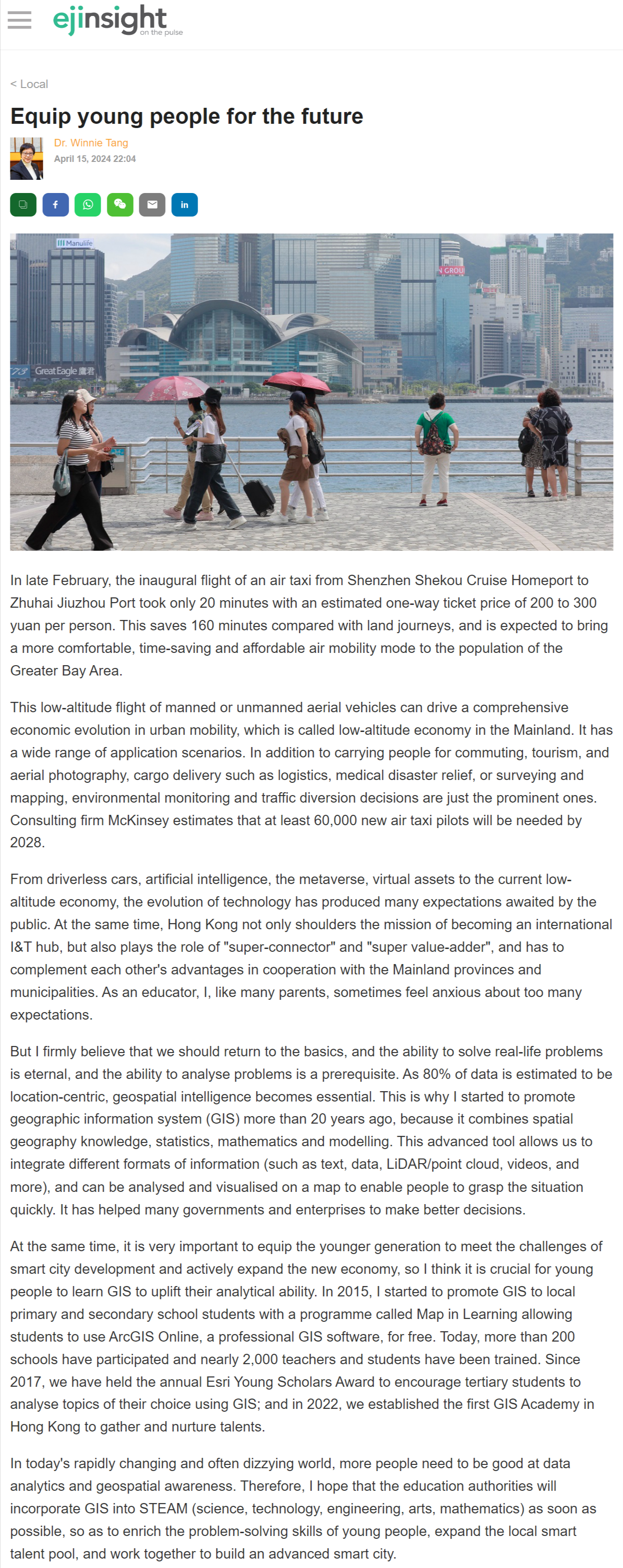網上版請按此

Equip young people for the future
In late February, the inaugural flight of an air taxi from Shenzhen Shekou Cruise Homeport to Zhuhai Jiuzhou Port took only 20 minutes with an estimated one-way ticket price of 200 to 300 yuan per person. This saves 160 minutes compared with land journeys, and is expected to bring a more comfortable, time-saving and affordable air mobility mode to the population of the Greater Bay Area.
This low-altitude flight of manned or unmanned aerial vehicles can drive a comprehensive economic evolution in urban mobility, which is called low-altitude economy in the Mainland. It has a wide range of application scenarios. In addition to carrying people for commuting, tourism, and aerial photography, cargo delivery such as logistics, medical disaster relief, or surveying and mapping, environmental monitoring and traffic diversion decisions are just the prominent ones. Consulting firm McKinsey estimates that at least 60,000 new air taxi pilots will be needed by 2028.
From driverless cars, artificial intelligence, the metaverse, virtual assets to the current low-altitude economy, the evolution of technology has produced many expectations awaited by the public. At the same time, Hong Kong not only shoulders the mission of becoming an international I&T hub, but also plays the role of "super-connector" and "super value-adder", and has to complement each other's advantages in cooperation with the Mainland provinces and municipalities. As an educator, I, like many parents, sometimes feel anxious about too many expectations.
But I firmly believe that we should return to the basics, and the ability to solve real-life problems is eternal, and the ability to analyse problems is a prerequisite. As 80% of data is estimated to be location-centric, geospatial intelligence becomes essential. This is why I started to promote geographic information system (GIS) more than 20 years ago, because it combines spatial geography knowledge, statistics, mathematics and modelling. This advanced tool allows us to integrate different formats of information (such as text, data, LiDAR/point cloud, videos, and more), and can be analysed and visualised on a map to enable people to grasp the situation quickly. It has helped many governments and enterprises to make better decisions.
At the same time, it is very important to equip the younger generation to meet the challenges of smart city development and actively expand the new economy, so I think it is crucial for young people to learn GIS to uplift their analytical ability. In 2015, I started to promote GIS to local primary and secondary school students with a programme called Map in Learning allowing students to use ArcGIS Online, a professional GIS software, for free. Today, more than 200 schools have participated and nearly 2,000 teachers and students have been trained. Since 2017, we have held the annual Esri Young Scholars Award to encourage tertiary students to analyse topics of their choice using GIS; and in 2022, we established the first GIS Academy in Hong Kong to gather and nurture talents.
In today's rapidly changing and often dizzying world, more people need to be good at data analytics and geospatial awareness. Therefore, I hope that the education authorities will incorporate GIS into STEAM (science, technology, engineering, arts, mathematics) as soon as possible, so as to enrich the problem-solving skills of young people, expand the local smart talent pool, and work together to build an advanced smart city.
Dr. Winnie Tang
Adjunct Professor, Department of Computer Science, Faculty of Engineering; Department of Geography, Faculty of Social Sciences; and Faculty of Architecture, The University of Hong Kong